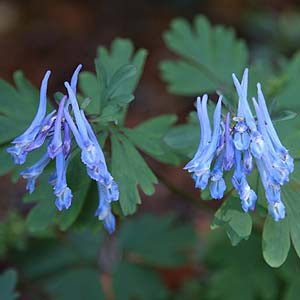
How to Grow Corydalis
Spring flowering corydalis with bright flowers are an excellent plant for shaded areas. They are a large group of woodland plants, ferny foliage and related to the bleeding heart plant, so similar growing conditions.
Some species, such as Corydalis yanhusuo commonly called the ‘Chinese poppy plant’, are used for medicinal purposes.
With many garden worthy varieties offered for sale online it is the blue flowering Corydalis flexuosa that is most sought after although the yellow flowering C. lutea also has its attractions.
This is a plant that has the ability to flower in fairly deep shade the ferny foliage is usually an attractive mid green, however some species with a more blue green, you could grow Corydalis for the foliage alone.
The blue flowering species such as Corydalis flexuosa, pictured right make a wonderful addition to any garden and will reach around 12 inches (30cm) in height.
Other species with flowers, ranging from white to pink are also available. The flowers are spurred flowers and mostly bloom in in spring, with occasional repeat flowering during summer, especially after rain in a cool period.
Corydalis Care
The keys to growing corydalis are soil, moisture and sun. In terms of climate USDA zones 5 to 8 are best, in other zones they will need protection from heat or cold.
They are best suited to a situation with dappled shade and a humus rich soil these wonderful little plants will spread by underground rhizomes however never seen to become invasive.
Corydalis prefer climates that do not receive high humidity. In warmer climates shade will be essential during summer months.
This is a plant that has tap roots, so they do not take that well to transplanting, although if you dig them when dormant you can often successfully seperate a clump.
Basic Care
- Grow in light shade to dappled shade.
- Humus rich moist soil with added compost during winter. Neutral soil pH too slightly alkaline
- Plant in a well drained position
- Propagation is by rhizome division or from seed
- Although they will self seed, if collected the seed needs to be sown when fresh for good germination.
In most climates, corydalis are dormant in summer as the weather gets hotter and in winter, they die back and disappear underground. They reappear in spring as the weather warms
Varieties
Varieties
- Corydalis lutea is the yellow flowering corydalis native to the European Alpine foothills.
- Corydalis solida is a pink flowering species however varieties can produce either purple, red, or white flowers.
- Corydalis anthriscifolia good blue green foliage and pink flowers, although this species does go dormant earlier than some others.
The Blue Flowering Corydalis
Include both Corydalis elata and Corydalis flexuosa.
It is C. flexuosa that makes an attractive woodland plant with dense racemes of bright blue flowers. Named cultivars such as Corydalis flexuosa ‘Porcelain Blue’ are well worth looking for. C.elata has deeper blue flowers
- Corydalis yanhusuo rhizoma is used in Chinese medicine.
- Corydalis ambigua is a blue flowering perennial herb native to China and Japan. In China the common name is Yan Hu Suo.
- Corydalis sempervirens is sometimes called the ‘Rock Harlequin’ and has yellow and pink flowers.
Where to buy
Varieties are available for sale from the following nurseries
DIGGING DOG NURSERY – phone (707) 937-1130
PO Box 471 Albion CA 95410

